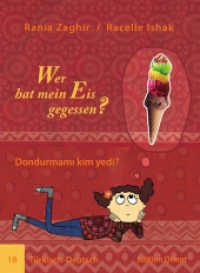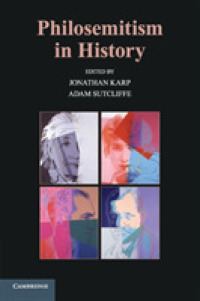- ホーム
- > 洋書
- > 英文書
- > Science / Mathematics
Full Description
How and why to write a movement? Who is the writer? Who is the reader? They may be choreographers working with dancers. They may be roboticists programming robots. They may be artists designing cartoons in computer animation. In all such fields the purpose is to express an intention about a dance, a specific motion or an action to perform, in terms of intelligible sequences of elementary movements, as a music score that would be devoted to motion representation. Unfortunately there is no universal language to write a motion. Motion languages live together in a Babel tower populated by biomechanists, dance notators, neuroscientists, computer scientists, choreographers, roboticists. Each community handles its own concepts and speaks its own language.
The book accounts for this diversity. Its origin is a unique workshop held at LAAS-CNRS in Toulouse in 2014.
Worldwide representatives of various communities met there. Their challenge was to reach a mutual understanding allowing a choreographer to access robotics concepts, or a computer scientist to understand the subtleties of dance notation. The liveliness of this multidisciplinary meeting is reflected by the book thank to the willingness of authors to share their own experiences with others.
Contents
Towards Behavioral Objects: A twofold Approach for a System of Notation to Design and Implement Behaviors in Non-Anthropomorphic Robotic Artifacts.- Laban Movement Analysis and Affective Movement Generation for Robots and other Nearliving Creatures.- Approaches to the Representation of Human Movement: Notation, Animation and Motion Capture.- The Problem of Recording Human Motion.-MovEngine - Developing a Movement Language for 3D Visualization and Composition of Dance.-
Bayesian Approaches for Learning of Primitive-Based Compact Representations of Complex Human Activities.- Beyond Watching: Action Understanding by Humans and Implications for Motion Planning by Interacting Robots.- Challenges for the Animation of Expressive Virtual Characters: The Standpoint of Sign Language and Theatrical Gestures.- Task Modelling for Reconstruction and Analysis of Folk Dances.- Dynamic Coordination Patterns in Tango Argentino: A Cross-Fertilization of Subjective ExplicationvMethods and Motion Capture.- Abstractions for Design-by-Humans of Heterogeneous Behaviors.- Annotating Everyday Grasps in Action.- Laban Movement Analysis - Scaffolding Human Movement to Multiply Possibilities and Choices.- Benesh Movement Notation for Humanoid Robots?.- The Origin of Dance: Evolutionary Significance on Ritualized Movements of Animals.- A Worked-Out Experience in Programming Humanoid Robots Via The Kinetography Laban.- Using Dynamics to Recognize Human Motion.- The Effect of Gravity on Perceived Affective Quality of Robot Movement.- Applications for Recording and Generating Human Body Motion with Labanotation.- Human Motion Tracking by Robots.








